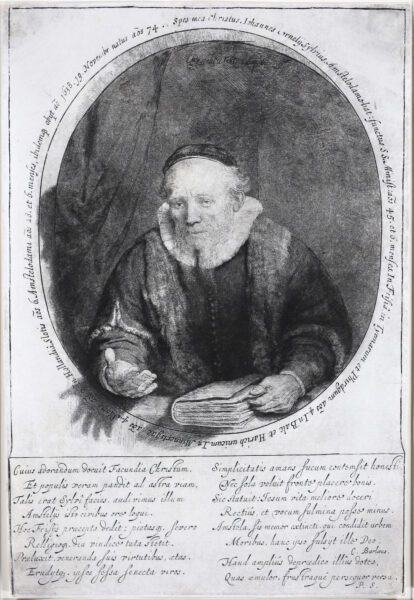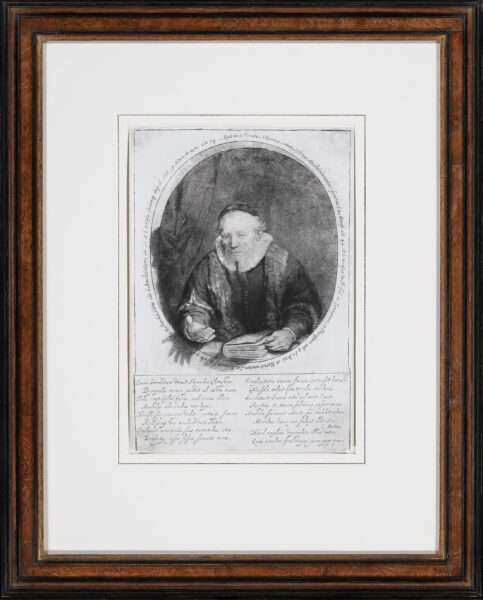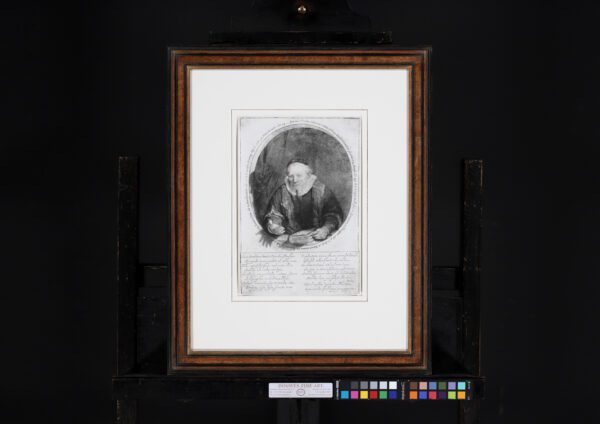“Jan Cornelius Sylvius, Preacher”, 1646
etching, drypoint and engraving: 27,9 x 18,6 cm;
signed and dated: Rembrandt f. 1646
Trimmed to the platemark.
"*" indicates required fields
Notes
Jan Cornelis Sylvius (1564-1638), a preacher in the Dutch Reformed Church in Amsterdam beginning in 1610, was the legal guardian of Rembrandt’s wife-to-be, Saskia van Uylenburgh. It was to Sylvius that Rembrandt made his appeal for Saskia’s hand.
The respected Amsterdam preacher had already died eight years ago when this portrait was created. It is thought that the artist undertook this print in an effort to repair his relationship with his late wife’s family, which he had alienated after her death, in 1642. Rembrandt portrays Sylvius in a lively pose, reaching out of the oval frame into the viewer’s space.
The inscription below the portrait is comprised of sixteen lines of Latin tekst by Caspar Barlaeus and Petrus Sylvius:
Spes mea Christus. Iohannes Cornelÿ Sylvius. Amstelodamo-bat: functus S S.Minist:aõs 45.et 6.menses. In Frisiâ. in Tyemarum et Phirdgum aõs 4. In Balco et Harich unicum. In Minnerts gae aõs 4.Slotis aõs 2. In Hollandiâ, Slotis aõs. Amstelodami aõs 28. et 6.menses, ibidemque obÿt ã o 1638.19. Novembr. natus aõs 74. ; upper center, in plate: Rembrandt f. 1646 ; in bottom quarter, in plate: Cuius adorandum docuit Facundia Christum, / Et populis veram pandit ad astra viam. / Talis erat Sylvî facies. audivimus illum / Amstelÿs is[?]o civibus ora loqui. / Hoc Frisÿs praecepta dedit; pietasque. fevero / Relligioque. diu vindica tuta s[?]it. / Praeluscit, veneranda fuis virtutibus, atas. / Erudytque. ipsos fossa senecta viros. / Simplicitatis amans fucum contomsit honesti, / Nec sola voluit fronto placero bonis. / Sic statuit: Fesum vita melioro doceri / Rectius, et vocum fulmina posso minus. / Amstola, sis memor extincti. qui condidit urbem / Moribus, hanc urso fulsÿt illo Deo. / C. Barlaeus. / Haud amplius depraedico illiûs dotis. / Auas aemulor, frustraque persequor verso. / P. S. ;
The translation is as follows:
His eloquence proclaimed that Christ must be worshipped, and opened the true way to heaven for the people. This is the likeness of Sylvius, with this mouth we have heard him address the citizens of Amsterdam, this mouth provided the Frisians with rules of life, under his strict care faith and religion long remained pure. In middle age his qualities still shone through, in old age he even still instructed adult men. He loved simplicity and hated hypocrisy, he wanted therefore not to please the good citizens only with outward display. His position was: it is better to portray Jesus’s teachings through a well-conducted life, blustering has no effect. Amsterdam, remember the deceased, who uplifted your city with his way of life and supported it with the help of God himself.
Literature
Bartsch 280; The New Hollstein Dutch no. 235, 2nd state (of II).
Plate not in existence – with Nowell-Usticke (1967):
“RRR – A very rare portrait”
“Rembrandt’s Earlier Etching of Jan Cornelis Sylvius” by Arthur M. Hind
Burlington Magazine for Connoisseurs, Vol. 23, No. 121 (Apr., 1913), pp. 22-23+25
Provenance
- Collection of Prince Karl Paar (Lugt 2009)
- Rudolph von Seydlitz (Lugt 2283)
- DG de Arozarena (Lugt 109).
- Private collection, Germany
- Private collection, The Netherlands





